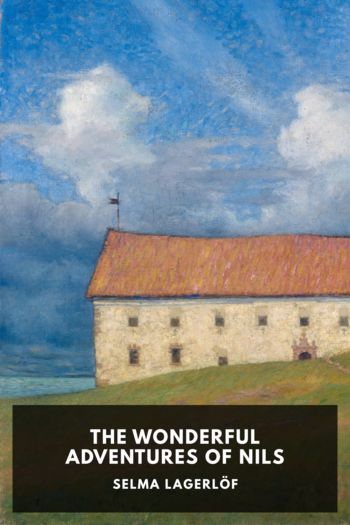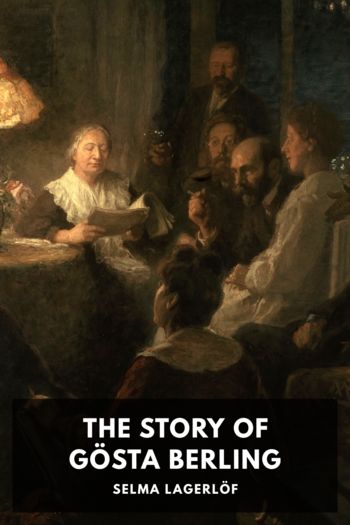The Wonderful Adventures of Nils by Selma Lagerlöf (i can read book club TXT) 📕

Description
In The Wonderful Adventures of Nils, Selma Lagerlöf tells the story of Nils Holgersson, a young boy who is transformed into an elf after a set of misdeeds. Escaping with his family’s farm goose he joins up with a flock of wild geese and travels with them across Sweden as they return to their annual nesting grounds in Lapland.
The story was originally written as a commission for the Swedish National Teachers’ Association to write a geography book for children and has become a firm favourite in the country. It’s been adapted for screen many times, translated into over 30 languages and, until recently, was the artwork on the 20 krona banknote.
Although originally published in English in two volumes—the second starting at “The Story of Karr and Grayskin”—here they are presented as a single combined story.
Read free book «The Wonderful Adventures of Nils by Selma Lagerlöf (i can read book club TXT) 📕» - read online or download for free at americanlibrarybooks.com
- Author: Selma Lagerlöf
Read book online «The Wonderful Adventures of Nils by Selma Lagerlöf (i can read book club TXT) 📕». Author - Selma Lagerlöf
“Both the fisherman and his mother were very kind to the poor mermaid, and she seemed to be happy with them. She grew more contented every day and helped the older woman with her work, and was exactly like any other island lass—only she was much prettier. One day the fisherman asked her if she would be his wife, and she did not object, but at once said yes.
“Preparations were made for the wedding. The mermaid dressed as a bride in her green, trailing robe with the shimmering pearl crown she had worn when the fisherman first saw her. There was neither church nor parson on the island at that time, so the bridal party seated themselves in the boats to row up to the first church they should find.
“The fisherman had the mermaid and his mother in his boat, and he rowed so well that he was far ahead of all the others. When he had come so far that he could see the islet in the river, where he won his bride, he could not help smiling.
“ ‘What are you smiling at?’ she asked.
“ ‘Oh, I’m thinking of that night when I hid your seal skin,’ answered the fisherman; for he felt so sure of her that he thought there was no longer any need for him to conceal anything.
“ ‘What are you saying?’ asked the bride, astonished. ‘Surely I have never possessed a seal skin!’ It appeared she had forgotten everything.
“ ‘Don’t you recollect how you danced with the mermaids?’ he asked.
“ ‘I don’t know what you mean,’ said the bride. ‘I think that you must have dreamed a strange dream last night.’
“If I show you your seal skin, you’ll probably believe me!’ laughed the fisherman, promptly turning the boat toward the islet. They stepped ashore and he brought the seal skin out from under the stone where he had hidden it.
“But the instant the bride set eyes on the seal skin she grasped it and drew it over her head. It snuggled close to her—as if there was life in it—and immediately she threw herself into the stream.
“The bridegroom saw her swim away and plunged into the water after her; but he could not catch up to her. When he saw that he couldn’t stop her in any other way, in his grief he seized his spear and hurled it. He aimed better than he had intended, for the poor mermaid gave a piercing shriek and disappeared in the depths.
“The fisherman stood on the strand waiting for her to appear again. He observed that the water around him began to take on a soft sheen, a beauty that he had never seen before. It shimmered in pink and white, like the colour-play on the inside of sea shells.
“As the glittering water lapped the shores, the fisherman thought that they too were transformed. They began to blossom and waft their perfumes. A soft sheen spread over them and they also took on a beauty which they had never possessed before.
“He understood how all this had come to pass. For it is thus with mermaids: one who beholds them must needs find them more beautiful than anyone else, and the mermaid’s blood being mixed with the water that bathed the shores, her beauty was transferred to both. All who saw them must love them and yearn for them. This was their legacy from the mermaid.”
When the stately old gentleman had got thus far in his narrative he turned to Clement and looked at him. Clement nodded reverently but made no comment, as he did not wish to cause a break in the story.
“Now you must bear this in mind, Clement,” the old gentleman continued, with a roguish glint in his eyes. “From that time on people emigrated to the islands. At first only fishermen and peasants settled there, but others, too, were attracted to them. One day the king and his earl sailed up the stream. They started at once to talk of these islands, having observed they were so situated that every vessel that sailed toward Lake Mälar had to pass them. The earl suggested that there ought to be a lock put on the channel which could be opened or closed at will, to let in merchant vessels and shut out pirates.
“This idea was carried out,” said the old gentleman, as he rose and began to trace in the sand again with his cane. “On the largest of these islands the earl erected a fortress with a strong tower, which was called ‘Kärnan.’ And around the island a wall was built. Here, at the north and south ends of the wall, they made gates and placed strong towers over them. Across the other islands they built bridges; these were likewise equipped with high towers. Out in the water, round about, they put a wreath of piles with bars that could open and close, so that no vessel could sail past without permission.
“Therefore you see, Clement, the four islands which had lain so long unnoticed were soon strongly fortified. But this was not all, for the shores and the sound tempted people, and before long they came from all quarters to settle there. They built a church, which has since been called ‘Storkyrkan.’ Here it stands, near the castle. And here, within the walls, were the little huts the pioneers built for themselves. They were primitive, but they served their purpose. More was not needed at that time to make the place pass for a city. And the city was named Stockholm.
“There came a day, Clement, when the earl who had begun the work went to his final rest, and Stockholm was without a master builder. Monks called the Gray Friars came to the country. Stockholm attracted them. They asked permission to erect a monastery there, so the king gave them an island—one of the smaller ones—this one facing Lake Mälar. There they built, and the place was called Gray Friars’





Comments (0)